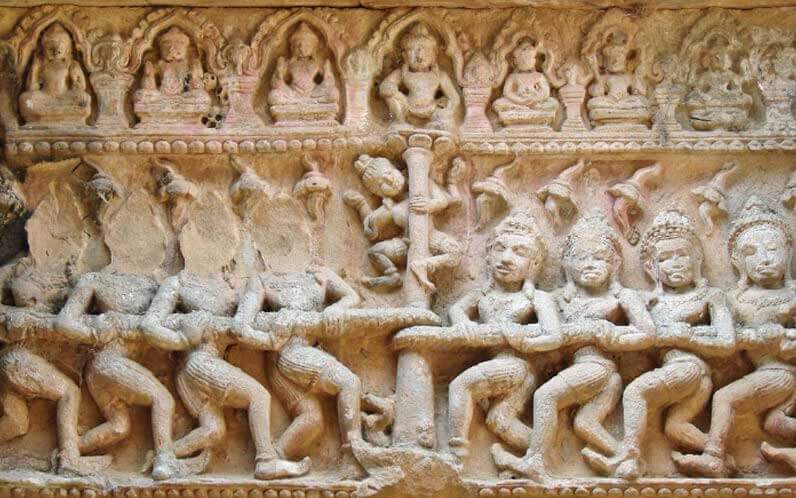Reading Time: 4 minutes
Dive into Saraswati’s symbolism: Arindam unveils her Vedic portrayal as wisdom, creativity, and purity personified exclusively in Different Truths.

Deep within the ancient Vedic texts, where knowledge flowed like the sacred Saraswati River, emerged a revered goddess: Saraswati. Embodying “vidya” (knowledge), “vak” (speech), and “kavya” (creative inspiration), she transcended the divine, becoming the very essence of wisdom, music, and the arts.
In the Rigveda, one of Hinduism’s oldest hymns, Saraswati is exalted as a river goddess, mirroring the sacred Saraswati River that symbolises the flow of wisdom and learning. Imagine a serene vision: a goddess seated on a lotus, radiating purity and enlightenment – that’s Saraswati, hailed as “the best of mothers, best of rivers, best of goddesses.”
Her four arms, each holding symbolic objects, represent the vastness of her knowledge and power.
But Saraswati is much more than a serene image. Her four arms, each holding symbolic objects, represent the vastness of her knowledge and power. The veena in her hand signifies the harmonious blend of knowledge and art, the mala (rosary) whispers of the continuous pursuit of wisdom through meditation, and the scriptures speak of her role as the divine source of knowledge.
White, the colour of her garments and the lotus she sits upon isn’t just about purity and clarity. It reflects her tranquil nature, echoing the wisdom of the swan, her sacred companion, symbolizing discernment, and the ability to differentiate between truth and falsehood.
As Hinduism blossomed into diverse sects and regional traditions, Saraswati’s portrayal evolved dynamically. Imagine her now, not just with four arms, but with many, each adorned with symbols representing different facets of learning, culture, and wisdom. This multiplicity underscores the vastness of her influence, encompassing various domains of human endeavour.
A pivotal moment in Saraswati’s mythology arises in the tale of “Samudra Manthan”…
A pivotal moment in Saraswati’s mythology arises in the tale of “Samudra Manthan,” the churning of the cosmic ocean. From the depths emerges not only Saraswati but also Lakshmi, another goddess symbolising wealth and prosperity. Together, they represent the symbiotic relationship between knowledge and prosperity, highlighting the importance of both in a fulfilling life.

This division of Saraswati into two distinct goddesses is mentioned in prominent scriptures like the Matsya Purana and the Padma Purana. Imagine Saraswati selflessly dividing herself to fulfil distinct cosmic purposes, marking a significant shift in Hindu iconography and mythology. While Saraswati continued to represent knowledge, music, and the arts, Lakshmi became associated with wealth and prosperity, embodying the multifaceted nature of Hindu deities and their attributes.
This isn’t just a mythological event; it’s a reminder of the balance we all seek. In paintings, sculptures, and temple carvings, Saraswati and Lakshmi stand together, showcasing their complementary attributes. They inspire devotees to seek harmony between intellectual pursuits and material well-being.
Regions like Bengal beautifully showcase this syncretic worship. Festivals like Saraswati Puja and Lakshmi Puja celebrate both goddesses, highlighting the inclusive nature of Hindu spirituality, where diverse deities are revered for their unique blessings.
Saraswati’s iconography isn’t static…
Saraswati’s iconography isn’t static; it’s a vibrant tapestry woven over centuries, reflecting diverse cultural, regional, and philosophical influences. From her Vedic origins to her transformation, she embodies the eternal quest for knowledge, wisdom, and spiritual enlightenment in Hindu tradition.
References:
1. Rigveda, Book 6, Hymn 61, Verse 7.
2. “The Goddess Sarasvati: Origin, Development, and Symbolism” by Kalyan Kumar Ganguli.
3. “Hindu Goddesses: Visions of the Divine Feminine in the Hindu Religious Tradition” by David Kinsley.
4. “Saraswati: The Goddess of Learning and Knowledge” by Subhash Kak.
5. Various Hindu scriptures, including the Vedas, Puranas, and Tantras.
6. “Goddess Lakshmi and Goddess Saraswati” by Acharya Vivek.
7. “Saraswati: The Goddess of Knowledge and Art” by S. D. Trivedi.
8. “Saraswati in Indian Art and Literature,” edited by Jyotindra Jain and Brajendra Nath Mukherjee.
9. “The Iconographic Development of Saraswati” by Bettina Bäumer.
10. “The Art and Iconography of Vishnu-Narayana” by T.A. Gopinatha Rao. * “Goddesses in Ancient India” by D.K. Printworld Ltd.
11. “The Divine Consort: Radha and the Goddesses of India” by John Stratton Hawley and Donna Marie Wulff.
Spotlight: How Tilottama became Saraswati!
The mythological tale of Tillotama and Brahma, intricately associated with the Hindu goddess Saraswati, offers a captivating insight into the origins and significance of this revered deity. While relatively lesser known, this myth serves as a poignant narrative within Hindu mythology, illuminating Saraswati’s divine journey from her early manifestation as Tillotama to her renowned status as the goddess of knowledge, music, and wisdom.
According to this myth, Tillotama emerges from the sacred body of Brahma, the creator deity in Hindu cosmology. Brahma, driven by a profound desire to manifest a companion embodying purity, wisdom, and divine grace, engages in intense meditation and tapas (spiritual practices). Through his devoted penance, Brahma brings forth Tillotama, a celestial maiden adorned with unparalleled beauty and wisdom.
The name Tillotama carries profound significance derived from Sanskrit etymology. “Tillo” denotes “beyond comparison” or “unparalleled,” while “tama” signifies “darkness” or “ignorance.” Hence, Tilottama is often interpreted as the epitome of surpassing brilliance and enlightenment, symbolising the dispelling of ignorance and darkness through divine wisdom and illumination.
In some renditions of the myth, Brahma becomes enamoured by Tilottama’s celestial allure and profound wisdom, finding himself unable to resist her allure. However, Tilottama, embodying purity, and wisdom, evades Brahma’s advances, transcending mortal desires, and ascends to the celestial realms, transcending the material realm to embody pure spiritual essence.
The myth of Tilottama and Brahma is intricately interwoven with Saraswati’s evolutionary narrative. Saraswati, revered as the goddess of knowledge, music, and arts, is often considered an incarnation or transformation of Tilottama. Through her divine association with Brahma, Saraswati inherits the sublime qualities of wisdom, creativity, and divine knowledge, assuming a revered position within the Hindu pantheon.
While variations exist across different sources and interpretations of this myth, its underlying essence serves to underscore Saraswati’s divine origins and her profound symbolism as a beacon of enlightenment, purity, and creative inspiration. Saraswati’s transformation from Tilottama to Saraswati manifests the eternal quest for knowledge, wisdom, and spiritual enlightenment within Hindu mythology, offering devotees profound insights into the divine journey of the goddess.
References:
1. “Hindu Goddesses: Visions of the Divine Feminine in the Hindu Religious Tradition” by David Kinsley.
2. “Sarasvati: The Goddess of Learning and Knowledge” by Subhash Kak.
3. “The Goddess Sarasvati: Origin, Development, and Symbolism” by Kalyan Kumar Ganguli.
4. “The Devi Bhagavatam: The Seventh Book” translated by Swami Vijnanananda.
5. “Myths and Symbols in Indian Art and Civilization” by Heinrich Zimmer.
Picture design by Anumita Roy
















Thank you for such an enriching explanation and interpretation!